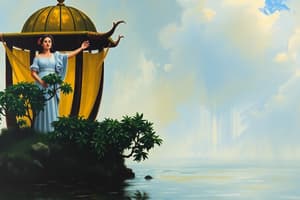Podcast
Questions and Answers
What term describes the perception of equilibrium between elements in a piece of art?
What term describes the perception of equilibrium between elements in a piece of art?
- Emphasis
- Rhythm
- Balance (correct)
- Unity
Which component describes the degree of lightness or darkness in color?
Which component describes the degree of lightness or darkness in color?
- Value (correct)
- Hue
- Intensity
- Texture
What is defined as a comparison of two elements that appear different in art?
What is defined as a comparison of two elements that appear different in art?
- Contrast (correct)
- Rhythm
- Emphasis
- Form
In visual arts, what is the term for a three-dimensional shape?
In visual arts, what is the term for a three-dimensional shape?
Which principle of visual arts is described as a focal point of interest in a piece?
Which principle of visual arts is described as a focal point of interest in a piece?
Which of the following best describes visual arts?
Which of the following best describes visual arts?
What is the primary characteristic of 2-D art?
What is the primary characteristic of 2-D art?
Which of the following is NOT considered a form of 3-D art?
Which of the following is NOT considered a form of 3-D art?
What distinguishes painting from other forms of visual arts?
What distinguishes painting from other forms of visual arts?
What role does a matrix play in printmaking?
What role does a matrix play in printmaking?
Which of the following forms of art could best be considered 3-D art?
Which of the following forms of art could best be considered 3-D art?
Which of the following materials is NOT typically associated with 3-D art creation?
Which of the following materials is NOT typically associated with 3-D art creation?
What defines the beauty in visual arts according to different art historical eras?
What defines the beauty in visual arts according to different art historical eras?
What does filmmaking primarily involve?
What does filmmaking primarily involve?
What best characterizes computer art?
What best characterizes computer art?
Which of the following is an example of a geographical factor influencing art?
Which of the following is an example of a geographical factor influencing art?
What role do social factors play in art?
What role do social factors play in art?
What defines mixed media in art?
What defines mixed media in art?
What element of visual arts is described as the path of a moving point through space?
What element of visual arts is described as the path of a moving point through space?
Which of the following is an example of a psychological factor in art?
Which of the following is an example of a psychological factor in art?
Which of these art forms is specifically dedicated to clothing and lifestyle accessories?
Which of these art forms is specifically dedicated to clothing and lifestyle accessories?
Flashcards are hidden until you start studying
Study Notes
Overview of Visual Arts
- Visual arts encompass arts created for visual perception, including drawing, painting, sculpture, and decorative arts.
- These arts evoke emotions using skill and imagination, rooted in ancient forms and modern techniques influenced by technological developments.
- Different art eras possess unique beauty principles, shifting from the elaborate Baroque style to the functional Prairie School style.
Dimensions of Visual Art
- 2-D Art: Involves forms like drawing, painting, and collage on flat surfaces; includes printmaking and photography, which can create a 3-D illusion.
- 3-D Art: Encompasses sculpture, ceramics, and architecture; artists begin with 2-D sketches before using specific materials to create three-dimensional works.
Mediums of Arts
- Drawing: Creating images using various tools and techniques.
- Painting: Applying pigments suspended in a medium onto surfaces like canvas or paper.
- Printmaking: Transferring images from a matrix to a flat surface using ink.
- Photography: Capturing images through the action of light.
- Filmmaking: The comprehensive process of creating motion pictures, involving scripting, shooting, and editing.
- Computer Art: Involves the use of computers in the production or display of artwork.
- Sculpture: Crafting three-dimensional art from materials like stone, metal, or wood.
- Mixed Media: Artwork that employs multiple mediums.
- Decorative Arts: Art focused on design and decoration.
- Fashion Arts: Dedicated to creating clothing and lifestyle accessories.
Influencing Factors in Arts
- Geographical Factors: Location influences material availability, e.g., marble sculptures in Romblon.
- Historical Factors: Events impact artistic expression, exemplified by Rizal’s "Noli Me Tangere."
- Social Factors: Artistic works often reflect societal purpose, as seen in Jonson’s and Petrarch’s compositions.
- Ideation Factors: Concepts from thinkers like Freud shape art, leading to movements like nudism.
- Psychological Factors: Artists’ background and experiences inform their work, e.g., Munch’s "The Sick Child."
- Technical Factors: The methods and tools utilized influence artistic style and execution.
Elements of Visual Arts
- Line: Represents movement and boundaries, indicating direction and texture.
- Shape: Defined areas formed by lines; can be geometric or organic.
- Color: Described by hue, value, and intensity; affects emotional response.
- Value: The lightness or darkness of a color.
- Form: Three-dimensional shapes that occupy space (length, height, depth).
- Space: The area occupied or formed by an object, or the absence thereof.
- Texture: Relates to perceived surface quality and feel.
Principles of Visual Arts
- Rhythm: Organizes visual elements in a pattern that guides the eye.
- Balance: Achieves equilibrium between various components in artwork.
- Emphasis: Highlights a focal point to draw interest.
- Contrast: Juxtaposes different elements (light vs. dark, colors) for dramatic effect.
- Unity: Ensures all parts of the artwork relate to each other cohesively.
Studying That Suits You
Use AI to generate personalized quizzes and flashcards to suit your learning preferences.




